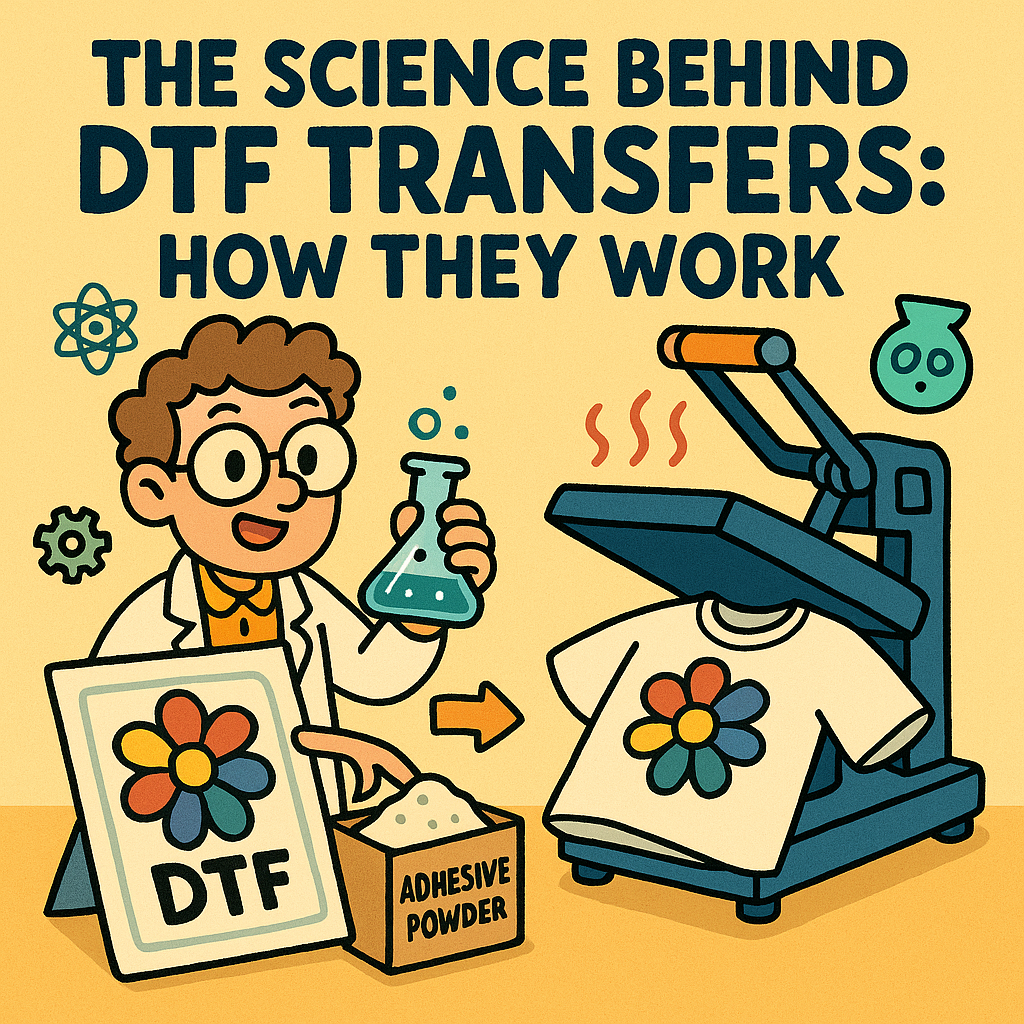
The Science Behind DTF Transfers: How They Work
Share
From creating personalized T-shirts to designing bulk custom apparel orders, Direct-to-Film (DTF) transfers are revolutionizing the custom printing industry. Their ease of use, versatility, and ability to produce vibrant, durable designs have made them a favorite among creators and small businesses alike. But what exactly makes DTF transfers so effective? Understanding the underlying science can help you improve your results and provide even better quality for your customers.
This in-depth guide will explore the technical process of DTF transfers—how the ink adheres to the film, the role of heat and pressure, and why this method is highly successful for custom printing. Whether you’re a beginner or an experienced professional, this blog will demystify the process and give you actionable insights to elevate your projects.
Need premium-quality supplies? Visit Texas Transfers and Designs for top-tier DTF products and printing essentials that guarantee stellar results.
What Makes DTF Transfers Unique?
Unlike traditional methods such as screen printing or direct-to-garment (DTG), DTF transfers rely on a specialized process to deliver high-quality prints onto garments of all types. From cotton to polyester blends, DTF transfers are compatible with a wide variety of fabrics, making them an extremely versatile option for custom printing businesses.
The unique strength of DTF lies in its innovative use of heat, adhesive powder, and film as intermediaries between your designs and the final fabric. This combination ensures vibrant colors, fine details, and unmatched durability—all without the limitations of other methods.
How Does the DTF Transfer Process Work?
At first glance, the process may seem complex, but it involves a series of straightforward steps that rely on precise chemical and physical reactions. Below is a breakdown of how DTF transfers operate from start to finish.
Step 1: Printing the Design on Transfer Film
The first step in any DTF project is to print the desired design onto a special PET (polyethylene terephthalate) film. These transfer sheets are specifically engineered to retain ink and play a crucial role in the process.
How It Works:
- Use of Water-Based Pigmented Ink: DTF relies on specially formulated water-based inks that produce vibrant and long-lasting colors. The ink layers are printed onto the transfer film in reverse to ensure that the final image appears correctly on the garment.
- Precision Printing: High-resolution DTF printers deposit multiple layers of ink precisely onto the film, including a white ink underbase that provides opacity and enhances the vibrancy of the colors.
If you’re looking for top-quality DTF transfer sheets, check out the PET film options available at Texas Transfers and Designs.
Step 2: Applying the Adhesive Powder
Once the design is printed on the film, an adhesive powder is applied to the inked areas of the transfer sheet. This is a critical step that ensures the design adheres seamlessly to the fabric during the heat press process.
The Science Behind Adhesive Powder:
- Thermoplastic Adhesive: DTF powders are typically made of a thermoplastic material that melts under heat, creating a bond between the printed design and the fabric.
- Targeted Application: Only the areas with ink attract the adhesive powder, thanks to the ink’s unique formulation. This ensures precision and prevents unwanted residue on the garment.
Many thermoplastic adhesive powders are versatile, working well on various fabrics such as cotton, polyester, and canvas. Make sure you’re using a high-quality adhesive powder for best results—browse available DTF adhesives here.
Step 3: The Curing Process
After applying the adhesive powder, the transfer sheet needs to be cured. This process ensures that the adhesive powder melts slightly and gets ready to bond with the fabric during heat pressing.
Controlled Heat Application:
- The curing step involves heating the transfer sheet to about 250°F–300°F for a short period.
- This helps activate the adhesive while also setting the ink.
Proper curing is key to avoiding adhesion problems later in the process. For creators looking to perfect their curing setups, reliable heat press accessories are available at Texas Transfers and Designs.
Step 4: Transferring the Design Onto the Garment
Now comes the exciting part—applying the design to the fabric. This step utilizes heat and pressure to make the transfer permanent.
The Heat and Pressure Breakdown:
- Heat: The transfer sheet is placed against the fabric and pressed at 300°F–325°F (follow your specific transfer instructions). The heat reactivates the adhesive powder and causes it to melt, securely bonding the ink and adhesive combination to the fibers of the fabric.
- Pressure: Medium-to-firm pressure is applied uniformly for about 10–15 seconds. This pressure forces the adhesive and ink into the fabric weave, ensuring a durable, long-lasting bond.
The precise combination of heat and pressure ensures the transfer is evenly bonded, leaving a professional-quality finish.
Step 5: Peeling the Transfer Film
Once the press is complete, the transfer film is peeled away, leaving the design on the garment. The type of film (hot peel or cold peel) determines when this step should be performed.
Timing Matters:
- Hot Peel Film: Peel the sheet while it’s still warm.
- Cold Peel Film: Allow the transfer to cool completely before peeling for best results.
When done correctly, this step reveals a bright, flawless image that’s ready to wear or sell.
Step 6: Final Press (Optional)
For added durability, a second press can be performed. This enhances the feel of the material and further secures the transfer.
Simply place a sheet of parchment paper or a silicone layer over the design and press again for 5–7 seconds. It’s an easy way to elevate your product quality.
Why Is DTF Transfer an Effective Printing Technique?
DTF transfers stand out for several important reasons:
- Vibrant Color and Detail: Multiple ink layers, combined with precision printing, allow for incredible levels of detail and color vibrancy.
- Durability: The chemical bonding created by the adhesive powder ensures that the design holds up to multiple washes and heavy use.
- Versatility: DTF transfers work on nearly all fabric types, eliminating the limitations of other methods.
- Cost-Efficiency: Especially for small or medium-sized businesses, DTF offers a cost-effective way to produce stunning results without heavy upfront investments.
Understanding the science behind DTF transfers not only helps you appreciate the technology but also empowers you to optimize your process for even better results. By following the techniques outlined above and using high-quality supplies, you can ensure your DTF projects consistently exceed expectations.
Texas Transfers and Designs is your one-stop shop for premium DTF products, tools, and expert advice. Visit their website to explore a wide range of reliable materials and accessories, or get in touch with their support team if you have questions about perfecting your technique.
Start experimenting today and see just how far DTF transfers can take your custom printing projects!
